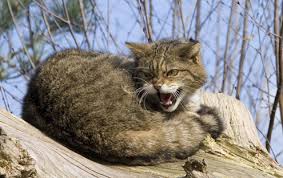Source(google.com.pk)
Wild Cats Wallpaper Biography
The wildcat is a small cat found throughout most of Africa, Europe, and southwest and central Asia into India, China, and Mongolia. Because of its wide range, it is classed by the IUCN as Least Concern.The wildcat (Felis silvestris) is a small cat found throughout most of Africa, Europe, and southwest and central Asia into India, China, and Mongolia. Because of its wide range, it is classed by the IUCN as Least Concern. However, crossbreeding with housecats is extensive, and has occurred throughout almost the entirety of the species' range.[2]
The wildcat shows a high degree of geographic variation. Asiatic subspecies have spotted, isabelline coats, African subspecies have sandy-grey fur with banded legs and red-backed ears, and European wildcats resemble heavily built striped tabbies with bushy tails, white chins and throats. All subspecies are generally larger than housecats, with longer legs and more robust bodies.[4] The actual number of subspecies is still debated, with some organisations recognising 22,[1] while others recognise only four, including the Chinese mountain cat, which was previously considered a species in its own right.[2]
Genetic, morphological and archaeological evidence suggests that the housecat was domesticated from the African wildcat, probably 9,000-10,000 years ago in the Fertile Crescent region of the Near East, coincident with the rise of agriculture and the need to protect harvests from grain-eating rodents. This domestication probably occurred when grain was yielded from the Agricultural Revolution onwards, which was stored in granaries that attracted rodents, which in turn attracted cats.[3]The wildcat's direct ancestor was Felis lunensis, or Martelli's wildcat, which lived in Europe as early as the late Pliocene. Fossil remains of the wildcat are common in cave deposits dating from the last ice age and the Holocene.[16] The European wildcat first appeared in its current form 2 million years ago, and reached the British Isles from mainland Europe 9000 years ago, at the end of the last ice age.[11] During the Late Pleistocene (possibly 50,000 years ago), the wildcat migrated from Europe into the Middle East, giving rise to the steppe wildcat phenotype. Within possibly 10,000 years, the steppe wildcat spread eastwards into Asia and southwards to Africa.[17]
The wildcat's closest living relatives are the sand cat, the Chinese mountain cat (which may be a subspecies of wildcat), the jungle cat and the black-footed cat.[18] As a whole, the wildcat (along with the jungle and leopard cat) represents a much less specialised form than the sand cat and manul. However, wildcat subspecies of the lybica group do exhibit some further specialisation, namely in the structure of the auditory bullae, which bears similarity to those of the sand cat and manul.[19]
The earliest evidence of wildcat domestication comes from a 9,500 years old Neolithic grave excavated in Shillourokambos, Cyprus, that contained the skeletons, laid close to one another, of both a human and a cat.[40][41][42] This discovery, combined with genetic studies, suggest that cats were probably domesticated in the Middle East, in the Fertile Crescent around the time of the development of agriculture and then they were brought to Cyprus and Egypt.[43]
Despite thousands of years of domestication, there is very little difference between the housecat and its wild ancestor, as its breeding is more subject to natural selection imposed by its environment, rather than artificial selection by humans.[25] The wildcat subspecies which gave rise to the housecat is most likely the African wildcat, based on genetics,[3] morphology,[24][25] and behaviour. The African wildcat lacks the sharply defined dorsal stripe present in its European counterpart, a trait which corresponds with the coat patterns found in striped tabbies. Also, like the African wildcat, the housecat's tail is usually thin, rather than thick and bushy like the European wildcat's.[44] In contrast to European wildcats, which are notoriously difficult to tame,[24][45] hand-reared African wildcats behave almost exactly like domestic tabbies, but are more intolerant of other cats, and almost invariably drive away their siblings, mates, and grown kittens.[46] Further evidence of an African origin for the housecat is present in the African wildcat's growth; like housecat kittens, African wildcat kittens undergo rapid physical development during the first two weeks of life. In contrast, European wildcat kittens develop much more slowly.[47] The baculi of European domestic cats bear closer resemblance to those of local, rather than African wildcats, thus indicating that crossbreeding between housecats and wildcats of European origin has been extensive.[46]












Wild Cats Wallpaper Biography
The wildcat is a small cat found throughout most of Africa, Europe, and southwest and central Asia into India, China, and Mongolia. Because of its wide range, it is classed by the IUCN as Least Concern.The wildcat (Felis silvestris) is a small cat found throughout most of Africa, Europe, and southwest and central Asia into India, China, and Mongolia. Because of its wide range, it is classed by the IUCN as Least Concern. However, crossbreeding with housecats is extensive, and has occurred throughout almost the entirety of the species' range.[2]
The wildcat shows a high degree of geographic variation. Asiatic subspecies have spotted, isabelline coats, African subspecies have sandy-grey fur with banded legs and red-backed ears, and European wildcats resemble heavily built striped tabbies with bushy tails, white chins and throats. All subspecies are generally larger than housecats, with longer legs and more robust bodies.[4] The actual number of subspecies is still debated, with some organisations recognising 22,[1] while others recognise only four, including the Chinese mountain cat, which was previously considered a species in its own right.[2]
Genetic, morphological and archaeological evidence suggests that the housecat was domesticated from the African wildcat, probably 9,000-10,000 years ago in the Fertile Crescent region of the Near East, coincident with the rise of agriculture and the need to protect harvests from grain-eating rodents. This domestication probably occurred when grain was yielded from the Agricultural Revolution onwards, which was stored in granaries that attracted rodents, which in turn attracted cats.[3]The wildcat's direct ancestor was Felis lunensis, or Martelli's wildcat, which lived in Europe as early as the late Pliocene. Fossil remains of the wildcat are common in cave deposits dating from the last ice age and the Holocene.[16] The European wildcat first appeared in its current form 2 million years ago, and reached the British Isles from mainland Europe 9000 years ago, at the end of the last ice age.[11] During the Late Pleistocene (possibly 50,000 years ago), the wildcat migrated from Europe into the Middle East, giving rise to the steppe wildcat phenotype. Within possibly 10,000 years, the steppe wildcat spread eastwards into Asia and southwards to Africa.[17]
The wildcat's closest living relatives are the sand cat, the Chinese mountain cat (which may be a subspecies of wildcat), the jungle cat and the black-footed cat.[18] As a whole, the wildcat (along with the jungle and leopard cat) represents a much less specialised form than the sand cat and manul. However, wildcat subspecies of the lybica group do exhibit some further specialisation, namely in the structure of the auditory bullae, which bears similarity to those of the sand cat and manul.[19]
The earliest evidence of wildcat domestication comes from a 9,500 years old Neolithic grave excavated in Shillourokambos, Cyprus, that contained the skeletons, laid close to one another, of both a human and a cat.[40][41][42] This discovery, combined with genetic studies, suggest that cats were probably domesticated in the Middle East, in the Fertile Crescent around the time of the development of agriculture and then they were brought to Cyprus and Egypt.[43]
Despite thousands of years of domestication, there is very little difference between the housecat and its wild ancestor, as its breeding is more subject to natural selection imposed by its environment, rather than artificial selection by humans.[25] The wildcat subspecies which gave rise to the housecat is most likely the African wildcat, based on genetics,[3] morphology,[24][25] and behaviour. The African wildcat lacks the sharply defined dorsal stripe present in its European counterpart, a trait which corresponds with the coat patterns found in striped tabbies. Also, like the African wildcat, the housecat's tail is usually thin, rather than thick and bushy like the European wildcat's.[44] In contrast to European wildcats, which are notoriously difficult to tame,[24][45] hand-reared African wildcats behave almost exactly like domestic tabbies, but are more intolerant of other cats, and almost invariably drive away their siblings, mates, and grown kittens.[46] Further evidence of an African origin for the housecat is present in the African wildcat's growth; like housecat kittens, African wildcat kittens undergo rapid physical development during the first two weeks of life. In contrast, European wildcat kittens develop much more slowly.[47] The baculi of European domestic cats bear closer resemblance to those of local, rather than African wildcats, thus indicating that crossbreeding between housecats and wildcats of European origin has been extensive.[46]
Wild Cats Wallpaper
Wild Cats Wallpaper
Wild Cats Wallpaper
Wild Cats Wallpaper

Wild Cats Wallpaper

Wild Cats Wallpaper

Wild Cats Wallpaper

Wild Cats Wallpaper

Wild Cats Wallpaper

Wild Cats Wallpaper

Wild Cats Wallpaper

Wild Cats Wallpaper

Wild Cats Wallpaper
No comments:
Post a Comment